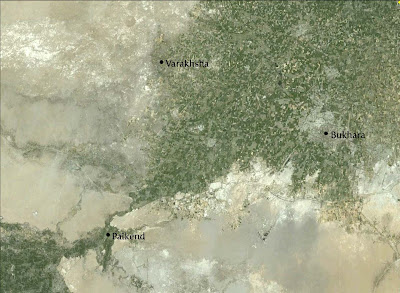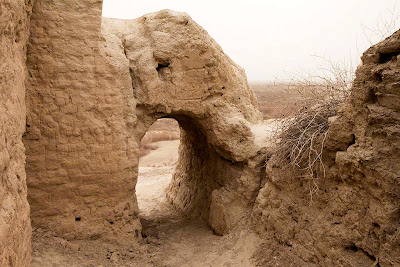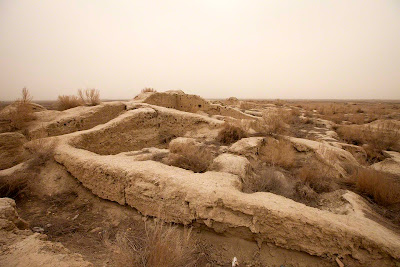Uzbekistan | Paikend | Varakhsha
I already mentioned the Kushans, who may have ruled Bukhara when the Magok-i Attari was first constructed. After the Kushans, around the beginning of the sixth century, Sogdiana fell under the sway of the Hephthalites, perhaps descendants of the Yuezhi, who themselves may have been Blonde-Haired Blue-Eyed Proto-Hippie Potheads but exact origins unclear.
The Hephthalites emerged in the fifth century a.d. and at the peak of their empire controlled much of East Turkistan (current day Xinjiang Province China, Afghanistan, and northwest India. According to one contemporary historian, the word “hephthalite” is derived from the Sogdian word for “strong man” Although the Hephthalites may have claimed suzerainty over the city-states of the Zerafshan Valley the Sogdians probably enjoyed a degree of autonomy, and by 563 a.d. Hephthalite influence in the region had ended altogether.
The Hephthalites emerged in the fifth century a.d. and at the peak of their empire controlled much of East Turkistan (current day Xinjiang Province China, Afghanistan, and northwest India. According to one contemporary historian, the word “hephthalite” is derived from the Sogdian word for “strong man” Although the Hephthalites may have claimed suzerainty over the city-states of the Zerafshan Valley the Sogdians probably enjoyed a degree of autonomy, and by 563 a.d. Hephthalite influence in the region had ended altogether.
It was around this time that the Ark in Bukhara and the various small settlements surrounding it had coalesced into an important city. Still, it was one of numerous cities in the Bukhara Oasis and not necessarily the most dominant. Varakhsha, on what was then the western edge of the Bukhara Oasis (its ruins are now in the desert), and Paikend (also Baikand), on the very southern edge of the oasis, were both substantial, well-fortified cities older than Bukhara itself. Indeed, according to the ten-century historian Narshakhi a trader who went to Bagdad was more likely to brag that he was from Paikend than from Bukhara. These cities of the Bukhara oasis and the other loosely aligned city-states which made up Sogdiana dominated trade on the Silk Road arteries stretching from China and India to Byzantium, southern Russia and northern Africa, and their language, an early form of Iranian, became the lingua franca of commerce.
Locations of Paikend and Varakhsha (click on images for enlargements)
Paikend, twenty-eight miles southwest of Bukhara, was an important caravan stop on the Merv-Bukhara-Amul (at the Amu Darya Crossing)-Samarkand route. Attacked and largely destroyed by invading Arabs in the 710s, it was partially rebuilt but probably never recovered its former prominence. It is now in ruins.
Ruins of Paikend
Southern entrance to the city. Stalls used by merchants can still be seen at top, just left of center.
Remains of what were probably residences
View of vineyards from the walls of the city
Ruins of Varakhsha
Varakhsha, twenty miles west-northwest of Bukhara, probably exceeded Bukhara in importance during its heyday. It boasted of impressive palaces used by Sogdian rulers. Once in the cultivated part of the Bukhara oasis, it may have been abandoned for lack of water as the oasis contracted.
Ruins of Varakhsha
Ruins of Varakhsha
Ruins of Varakhsha
Ruins of Varakhsha
From Varakhsha the desert now stretches for hundreds of miles to the west
The religions practiced in Sogdia were indicative of these trade links with varying cultures. Buddhism, which had entered the region via Bactria, was in decline by the sixth century, but Zoroastrianism, the dominant religion of the Sassanian Empire to the southwest, was flourishing. Nestorian Christianity, stamped out in Byzantium, had spread eastward, and as early as 334 a.d. there was a Christian bishop in Merv, just south of the Amu Darya. By the sixth century Nestorian Christians were established in Samarkand, and probably in Bukhara. Manichaeism and a host of breakaway sects and chthonic cults also found followers among the Sogdians. By the end of the sixth century Sogdiana was flourishing, but dangers lurked just beyond the horizon. It was probably at this time that the Sogdians constructed the Kanpirak, or “Old Woman, the 150 or-more-long wall which surrounded most of the Bukhara Oasis and served as a bulwark against the hostile Turkish nomads who inhabited the deserts and steppes to the north. The invaders who would bring down Sogdiana and forever change the way of life in the Land Beyond the Rivers came not from the north, however, but from the south, in form of Arabs who came proclaiming the new religion of Islam.













